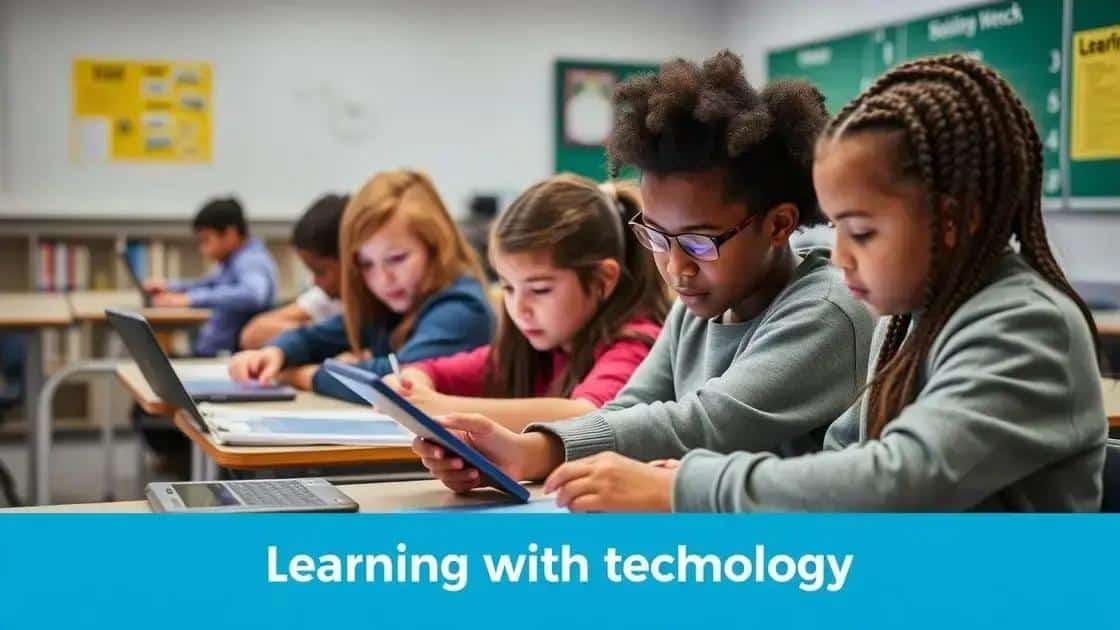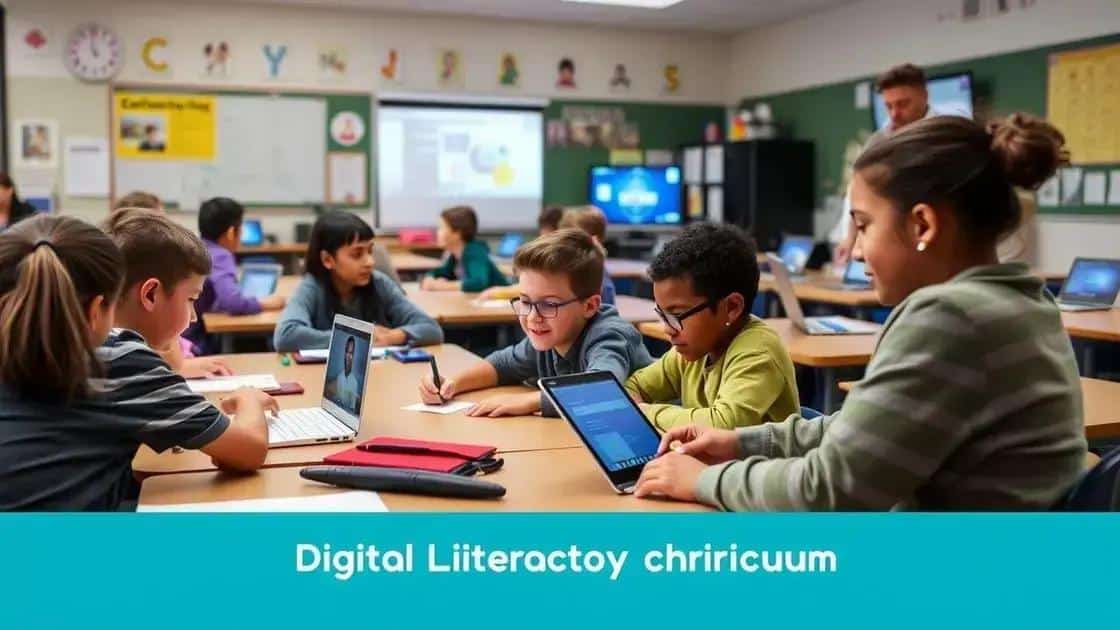Insights on digital literacy curriculum to enhance learning

Digital literacy curriculum equips students with essential skills to effectively navigate, evaluate, and create information using technology, preparing them for academic success and future careers.
Insights on digital literacy curriculum are becoming increasingly essential for educators aiming to prepare students for a technology-rich future. Have you ever wondered how a well-structured curriculum can change the way students interact with digital tools?
Understanding digital literacy and its importance
Understanding digital literacy is crucial for modern education. It refers to the ability to effectively navigate, evaluate, and create information using a range of digital technologies. This skill is not just about knowing how to use devices; it encompasses the knowledge necessary to engage with digital content critically.
To grasp the importance of digital literacy, consider its role in everyday life. It allows individuals to access resources, communicate efficiently, and solve problems using digital tools. In essence, digital literacy empowers learners to thrive in an increasingly digital world.
Key Aspects of Digital Literacy
Digital literacy involves various competencies that combine to form this essential skill set. Here are some key aspects:
- Information Literacy: The ability to find, evaluate, and use information effectively.
- Communication and Collaboration: Using digital tools to communicate and collaborate with others.
- Technical Proficiency: Understanding how to operate and troubleshoot different technologies.
- Digital Rights and Responsibilities: Being aware of the legal and ethical implications of using digital content.
By focusing on these aspects, educators can foster a comprehensive understanding of digital literacy among students. This will prepare them to face challenges and seize opportunities in their academic and professional lives.
The Role of Digital Literacy in Education
Incorporating digital literacy into education enriches the learning experience. Students who possess these skills can engage with content beyond textbooks. They can explore online resources, participate in discussions, and present their findings using various digital formats.
The integration of digital literacy into curricula also promotes critical thinking. Rather than passively consuming information, students learn to question sources, compare perspectives, and develop their own views. This active engagement is essential for nurturing informed citizens in our society.
Furthermore, as technology evolves, so should education. Schools and educators must prioritize training in digital literacy to ensure students are equipped for future challenges. This includes not only academic settings but also preparing them for workplaces that increasingly rely on digital tools.
Key components of an effective digital literacy curriculum

Key components of an effective digital literacy curriculum include various skills and resources that help students thrive in a technology-driven world. Recognizing what makes up this curriculum can significantly enhance teaching and learning processes.
An effective curriculum should start with an understanding of the essential skills students need. These include not only technical skills for using devices but also critical thinking skills to analyze information. Educators need to weave these elements throughout the learning experience.
Essential Skills in Digital Literacy
Here are some crucial skills to consider when developing a digital literacy curriculum:
- Technical Skills: Understanding how to operate computers, tablets, and software.
- Information Evaluation: Ability to assess the credibility and relevance of internet sources.
- Communication Skills: Engaging effectively using digital communication tools.
- Digital Citizenship: Understanding ethics, privacy, and security in the digital space.
Each of these components plays a vital role in preparing students for future challenges. When students learn to evaluate information effectively, they become more informed users of technology.
Incorporating Technology
To create an engaging digital literacy curriculum, it’s essential to incorporate various technologies. Using tools like blogs, podcasts, and video production can provide students with hands-on experience. This not only helps them learn how to use technology but also enhances their creativity.
Moreover, collaboration tools such as Google Docs and discussion forums are great ways for students to work together. This promotes teamwork and communication, which are crucial for success in both academic and future work settings. Integrating these tools into lessons keeps students engaged and encourages active learning.
Ultimately, the success of a digital literacy curriculum lies in its ability to adapt and grow. As technology changes, so must the curriculum. Regular updates and revisions ensure that students learn the most relevant skills for today’s job market and society.
Strategies for implementing digital literacy in classrooms
Implementing digital literacy in classrooms involves specific strategies that enhance students’ learning experiences. By integrating these strategies, educators can create an engaging environment that promotes essential skills.
One effective strategy is to incorporate project-based learning. This method allows students to work on real-world problems while utilizing digital tools. For example, students can create presentations or conduct research using online resources. This hands-on approach makes learning relevant and meaningful.
Utilizing Technology Effectively
To successfully implement digital literacy, teachers should utilize technology in different ways. Here are some suggestions:
- Interactive Tools: Use online platforms like Kahoot or Quizlet to create interactive quizzes.
- Collaborative Projects: Encourage group work using tools like Google Docs, allowing students to collaborate in real time.
- Flipped Classroom: Assign video lectures for homework, freeing up class time for discussions and hands-on activities.
- Digital Portfolios: Have students create digital portfolios to showcase their work and reflect on their learning.
Incorporating these technologies not only improves students’ technical skills but also fosters collaboration and critical thinking. When students actively engage with the material, they develop a deeper understanding of digital literacy.
Professional Development for Teachers
Another vital strategy is to provide ongoing professional development for teachers. Training sessions can focus on the latest digital tools and teaching strategies. This ensures that educators feel confident in their ability to teach digital literacy effectively.
Workshops and collaborative sessions allow teachers to share resources and experiences, making it easier to implement new technologies in their classrooms. As teachers become more proficient, they can model effective practices for their students.
Additionally, offering support and resources, such as access to online courses and instructional materials, can help teachers stay updated with the latest trends in digital literacy. When teachers are equipped with the necessary tools, students benefit tremendously.
The role of educators in fostering digital literacy

The role of educators in fostering digital literacy is crucial for students’ success in a technology-driven world. Teachers not only impart knowledge but also serve as guides to help students navigate the digital landscape.
One of the primary responsibilities of educators is to create an engaging learning environment. By integrating digital literacy into their teaching practices, they ensure students are equipped with essential skills. This includes teaching students how to use various digital tools and platforms effectively, focusing on both information sharing and collaboration.
Supporting Critical Thinking
Educators also play a vital role in nurturing critical thinking skills. They can encourage students to question sources, analyze information, and form their own opinions. For instance, during lessons, teachers might ask students to evaluate the credibility of online resources.
- Provide Guidance: Help students understand how to discern credible sources from unreliable ones.
- Engage in Discussions: Facilitate group discussions that allow students to articulate their thoughts and challenge others’ views.
- Encourage Research: Assign projects that require students to gather information from diverse digital platforms.
- Model Critical Thinking: Demonstrate how to approach problems with a critical mindset.
This approach cultivates a generation of learners who are not only adept at using technology but also critical consumers of information.
Professional Development for Educators
To effectively foster digital literacy, educators themselves must engage in continuous learning. Professional development opportunities can provide teachers with the latest tools and strategies to enhance their teaching practices. Workshops that focus on digital tools or innovative teaching methods can empower educators to support their students better.
By collaborating with colleagues, teachers can share best practices and learn from each other’s experiences. Support networks can also help them stay updated on emerging trends in digital literacy. This ensures that teachers remain engaged and motivated to foster a vibrant learning atmosphere.
Ultimately, educators need to embrace their role as digital literacy advocates. By proactively incorporating these skills into their curriculum, they prepare students not just for academic success but for life in a society that increasingly relies on digital communication and knowledge.
FAQ – Frequently Asked Questions about Digital Literacy in Education
What is digital literacy?
Digital literacy refers to the skills required to navigate, evaluate, and create information using digital technologies.
Why is digital literacy important for students?
It prepares students for academic success and future careers in an increasingly technology-driven world.
How can educators promote digital literacy?
Educators can promote digital literacy by using interactive tools, project-based learning, and incorporating critical thinking exercises in their lessons.
What role does teacher training play in digital literacy?
Ongoing teacher training is essential for ensuring educators are equipped with the latest tools and strategies to effectively teach digital literacy.





